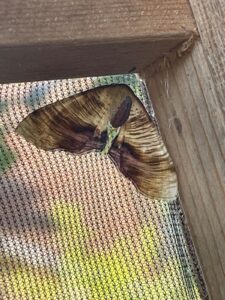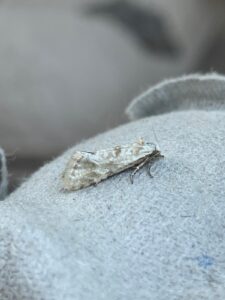20 June 2023
17 June 2023 – Old and New

The prehistoric-looking Beautiful Golden Y (Autographa pulchrina) is a new catch for me. The golden yellow spots, combined with the purple and mauve wings, make for an exceedingly striking appearance. The tufted thorax gives an air of a tiny Stegosaurus, perched fearsomely upon a flower petal. This moth flies in June and early July, earlier than its close relative, the less fortunately named Plain Golden Y (Autographa jota).

The Green Silver-lines (Pseudoips prasinana) would have been another immediate identification, if the small bands of mauve on the bottom of its wings had been more apparent. This moth usually has a distinct red-orange line hemming its costal edges. However, its red legs and antennae give away its identity. This moth is well-known for its bright green appearance, being one of the few green local British moths, and relatively common. I anticipate that we’ll be seeing more Green Silver-lines in the very near future!

The Blood-vein (Timandra comae) was another first! I’d never seen this moth in the ‘flesh’ before, but its visceral name stood out in my memory among the others from the moth guide. The stark mauve line across its wings (which is not, in fact, a real vein) is impressively straight compared to other moths of the same family. Given how flighty this moth was as soon as I took it out of the trap, I’m lucky to have gotten a picture at all!

The Scorched Wing (Plagodis dolabraria) is a familiar visitor to the gardens but this rather striking photograph is worthy of inclusion.
A quick confirmation with Charles Fletcher this morning revealed a new species for Shandy Hall! Cochylimorpha straminea, a micro-moth common throughout Britain, is distinguished by its pale grey-brown wing color and white, feathered-like costal edge that appears to me almost like the tufting on the edge of a rug. Micro-moths of this ilk can be difficult to identify, for their smaller size, and because the differences from moth to moth can be nearly microscopic. However, the feeling of adding another moth species to the Shandy Hall records is a fitting reward for hours spent poring over the field guide. 451 species becomes 452!

Post by Autumn Cortright (UPenn intern).
Recent Moths
- 25 July 2023 – Collective Noun for Hawkmoths
- MOTH LIST to August 2023 with links
- 28 July 2023 – TRIPLE New Species Alert!
- 18 July 2023 – A Golden…Plusia!
- 13 July 2023 – Arts and Sciences
- 10 July 2023 – Rise of the Yellow Underwings
- 4 July 2023 – Cold-weather Catch
- 4 July 2023 – Mother of Pearl, an Inspiration to Science
- 28 June 2023 – Buff-tipped Marble
- 23 June 2023 – Moth or Butterfly?
- 20 June 2023 – Bee, Straw, Emerald and a Ghost
- 17 June 2023 – Old and New






